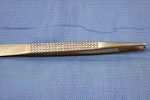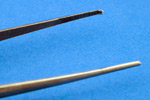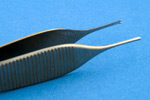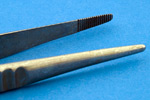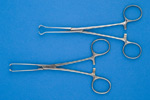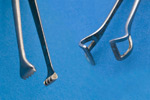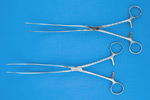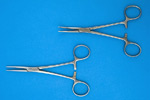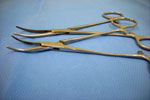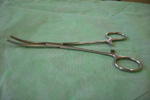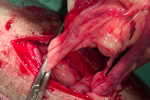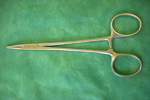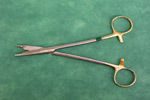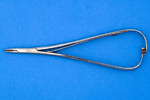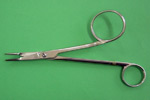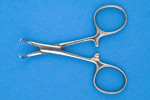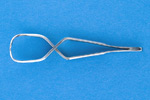Equipment Instruments
Unit 9: Basic Instruments
Topic 2b: Grasping Instruments
Surgical manipulation of tissues by hand or instrument produces tissue trauma. This trauma can be minimised by using appropriate instruments for specific tissues, avoiding excessive force to hold tissues, applying instruments on tissues only for the required period of holding, and avoiding repeated re-grasping of tissues. Instruments for grasping have different designs, which should be considered when selecting the instrument. These are:
- smooth versus toothed
- locking versus non-locking
- crushing versus non-crushing.
Grasping instruments are sometimes used to stabilise tissues away from the surgeon’s field or for easier tissue handling. These instruments have a locking mechanism that enables the tissue to be grasped without continuous action from the surgeon. They should be used judiciously and should not be allowed to remain on tissues for longer than necessary. Common examples include the use of Allis tissue forceps to hold the linea alba during an ovariohysterectomy or laparotomy, Babcock tissue forceps to hold the urinary bladder during cystotomy and Doyen intestinal forceps for intestinal anastomosis.
Thumb forceps

They are non-locking for greater manoeuvrability and to avoid prolonged grasping of tissues. Tissue forceps should be held with a pencil grip.
These instruments are used for stabilising and manipulating tissues, needles or swabs. They are designed to be held between the thumb and forefinger like a pen for more precise action and pressure applied to tissues, usually in the non-dominant hand.
- They are available in a variety of lengths, widths and jaw types.
- The tips can be smooth, serrated, or have small or large teeth.
- The minimum amount of tissue is grasped and the minimum amount of pressure is applied to produce a secure hold.

The greater pressure required to hold tissues with smooth-tipped tissue forceps is more traumatic than using tissue forceps with small teeth (Adson) or fine serrations (DeBakey).
Rat toothed forceps are designed specifically for holding tissues. The teeth permit a firm grip without crushing the tissues being held. Examples of these include the Bonney, Potts Smith and Adson tissue forceps.
Bonney forceps
Have 1:2 or 2:3 teeth and a metal insert behind the teeth for gripping needles.
They are a heavy robust instrument for use on tissues such as skin or the linea alba.
Potts Smith forceps
Longer, more delicate forceps for manipulating more delicate tissues such as gut.
Adson forceps
The shorter Adson tissue forceps (1:2 teeth) or Brown Adson forceps with multiple intermeshed fine teeth are also designed for use in delicate tissues.
Russian forceps
With a wide tip and deep grooved gripping surface may be used to manipulate tissues such as lung or atrial appendage.
Fine tissue forceps
Designed to stabilise and hold tissues, such as adventitia around a blood vessel, to aid dissection.They have fine serrations or teeth that intermesh.
An excellent example of these forceps is the DeBakey forceps used principally in cardiovascular and urogenital surgery.
Dressing forceps
Similar in design to tissue forceps, but are much stronger and more robust.
They are used to hold sponges or gauze during surgery and should not be used for handling tissues as they will cause a crush injury as the surgeon applies more pressure in an attempt to hold the tissues.
Grasping forceps
Grasping forceps are used to stabilise tissues away from the surgeon’s field or for easier tissue handling. These instruments have a locking mechanism that enables the tissue to be grasped without continuous action from the surgeon. They should be used judiciously and should not be allowed to remain on tissues for longer than necessary.
Allis tissue forceps
Strong sturdy instrument with a number of teeth on the gripping surface.
They may crush tissue and should be used on connective tissues and fascial planes only.
May be used to hold the linea alba during an ovariohysterectomy or laparotomy
Babcock intestinal forceps
Less traumatic to the tissues than the Allis forceps.
The gripping surface on the jaws has fine longitudinal striations.
May be used to hold the urinary bladder during cystotomy.
Noyes alligator forceps
Have a long thin shaft and pivot point near the short jaws at the tip of the instrument.
They can therefore enter small openings and are excellent for removing foreign bodies from structures such as the ear canal.
Doyen intestinal forceps
Designed specifically to hold the intestine without crushing.
They have long thin bowed jaws with the tips of the jaws meeting at the same time as the ratchets first teeth engage, providing a delicate, non-traumatic grip. The intestine should be held in the centre of the jaws to prevent crushing.
Bone Holding forceps
Designed for grasping bone. The jaws can have pointed tips for small bones or fragments, or have a serrated surface with pointed prongs at the tips to provide a solid non-slip grip on bigger tubular bones. Most have a ratchet that prevents slippage but if applied too tightly can crush bone.
A speed lock mechanism allows better control over the tightness of application while at the same time maintaining the grip.
Haemostatic forceps
Haemostats are available in a wide range of sizes and are either curved or straight and are designed to occlude bleeding blood vessels.
They are also designed to crush tissues placed between their jaws with the jaws meeting before the first teeth of the ratchet engage.
Halsted Mosquito haemostats
Halsted Mosquito haemostats are small delicate instruments.
Kelly and Crile haemostats are more robust.
The Kelly have transverse grooves on the distal half of the jaws only whilst the Crile have grooves over the entire surface.
When applied to a bleeding vessel the tips of the forceps are used to produce minimal tissue injury during haemorrhage control. The grooves on the jaws run at right angles to the long axis of the jaws.
Pedicle forceps
Rochester Carmalt forceps are designed for clamping vascular pedicles.
The grooves run parallel with the long axis of the jaws.
They are particularly useful in ligating ovarian and uterine pedicles.
Needle holders
Needle holders are grasping instruments designed to securely hold a needle for suturing.
They are robust and have short strong jaws with a box lock to withstand the pressures placed upon them. To improve grip and durability, tungsten carbide inserts for the surface of the jaws are available. The inserts can be replaced when worn.
The most commonly used needle holder is the Mayo-Hegar.
For maximum mechanical advantage and manoeuvrability, the needle holders are usually used with the three-finger grip with movement of the wrist used to follow the shape of the needle through the tissues during suture placement.
Alternatively, the needle holders may be "palmed" to facilitate needle placement through thick and tough tissues.
The needle should be grasped at or slightly off its mid-point towards the eye and perpendicular to the long axis of the needle holder. The locking mechanism is engaged before the needle is driven through the tissue with a single rotating motion of the hand, with an arc similar to that of the needle. The ability to obtain the desired amount and depth of tissue with a single action of each bite minimises tissue trauma from repeated attempts due to poor technique.
Other Needle holder patterns include:
The Olson-Hegar: Incorporates a scissor just caudal to the jaw.
The Mathieu: (The ratchet is at the rear of the instrument) is operated by the palm of the hand and therefore suffers in precision and feel for the tissues.
The Gillies pattern: Has a large thumb grip set at an angle to the other for use over the thumb.Also has a scissor incorporated into the jaws but does not have a ratchet.
Towel clamps
Used to secure the patient drapes directly to the skin and are positioned so that they can be tucked away under the edge of the drapes.
Backhaus towel clamp: The most common towel clamp - incorporates a ratchet.
Jones towel clamp: Has a bulldog grip.
